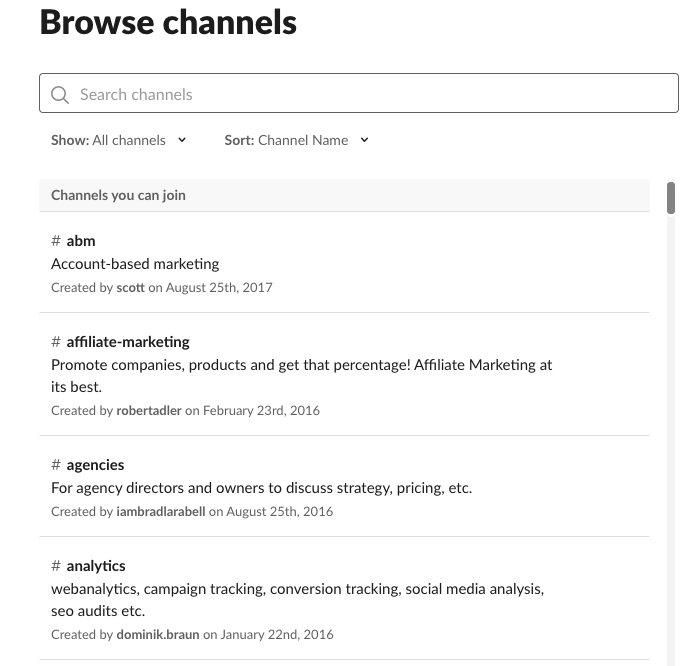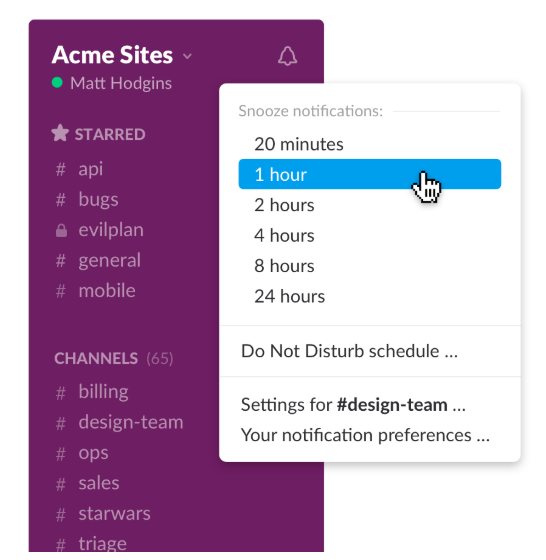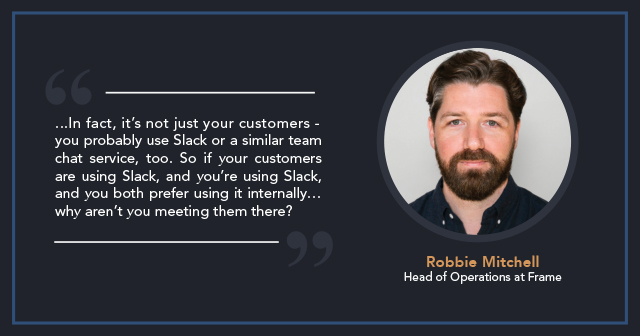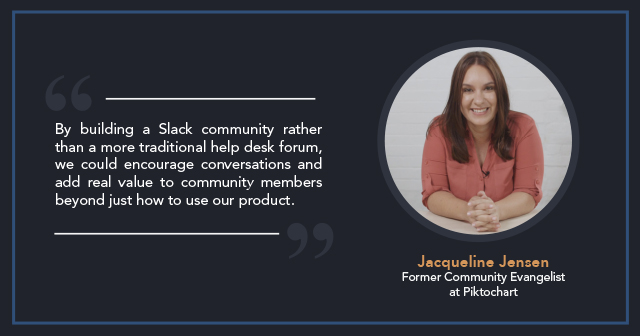Article's Content
Slack communities have grown 2.5 times since 2016 and have over a million members—a statistic that won’t surprise you if you’re part of a Slack community (or several).
Slack was created to be an internal communication tool for businesses, but thanks to the platform’s public channels, “organizations and individual consumers are flocking to the platform in droves, repurposing Slack as a public or at least external communication forum.”
These communities offer benefits beyond networking yet are grossly underutilized. Some of the people who have flocked to Slack don’t really know where to begin once they get there—they have no idea which Slack communities they should engage with or how to extract the most value from the platform. Enterprises, on the other hand, are unsure of Slack as an external communication platform and may not understand its benefits for their business.


So we decided to dive deep into the fast-paced world of Slack communities in order to clear up everyone’s questions and doubts about using the platform to drive business. This playbook is the result of our own participation in such communities and is designed to help both individuals and enterprises use the platform effectively.
Here’s how:
- If you are a marketer, developer, founder or a startup enthusiast, this playbook will help you understand the subtler aspects of joining Slack communities. We will walk you through the right approach to finding relevant communities and share tips and tricks to get the most from your engagement.
- If you’re part of an enterprise, this playbook will help you weigh the benefits of launching a Slack community for your users and reveal how you can use the platform in innovative ways.
It’s a long ride, so buckle up. Here’s a quick navigation menu to simplify things:
- How To get Value Out Of Communities On Slack
- How To Leverage Existing Slack Communities
- 3 Power Tips To Increase Visibility In Slack Communities
- Why Should Brands Create Their Own Slack Communities?
- 4 Questions That Companies Should Ask Themselves Before Launching A Slack Community
- How Can Your Internal Team Benefit From This Slack Community?
- Wrapping Things Up: Best Practices For Slack Communities In 2020
How To Get Value Out Of Communities On Slack
If you jump into hundreds of Slack communities before evaluating the benefits of each one, chances are you’ll end up buried under a pile of conversations and notifications you can’t keep track of—and no value to show for it.
So how do you ensure that you get value out of these communities? The answer is by picking ones that align with your purpose.


Here’s a step-by-step process to narrow down on Slack communities that align with your purpose:
Step 1: Research Relevant Slack Communities


To begin with, find Slack communities that match your interests. This will require some research and time, but it will ensure that you’re only joining communities you can contribute to.
Now here’s the challenge: With dozens of paid and free communities to choose from, just knowing where to start can be overwhelming.
We get that—fortunately, there are umpteen Slack directories, tools and articles to help you narrow the field.
- Slack List displays handpicked Slack communities across a range of interests
- Standuply’s list lists more than 2,000 Slack communities
- Slofile, is public Slack community database with live stats
- r/SlackHangouts subreddit
- An Ultimate List of 230+ Slack Communities by Sky
👉For sales and marketing folks, we’ve put together a list of most active and engaged Slack communities you should be part of. Check it out 👈
Step 2: Apply Filters To Shorten The List
If you are genuinely interested in networking, learning and adding value by participating in Slack communities, then you need to whittle down your list based on your goals and resources.
Here are two filters you can apply during your shortlisting process:
Is the community paid or free?

While both categories offer unique benefits, paid communities are often preferred over free ones. A paid model ensures that only earnest people sign up for the community. Such communities also discourage spam accounts and data scrapers, to an extent.
Is the community public or private?
There’s a growing debate within the fraternity over which is better. For example, people who are a part of private Slack communities often talk about enriching conversations, given that such communities are usually small and close-knit.
Public communities, on the other hand, usually do not have a barrier to entry, is easily accessible and allows marketers to expand their reach and network smoothly.
As you see, both these communities have their pros and cons. So take your pick.
Step 3: Join The Relevant Slack Channels


Slack communities have channels that are subsets of the central theme. For example, an online marketing community will most likely have channels that focus on #content marketing, #SEO, #PPC #marketing automation, and so on.
It’s important to join channels that actually matter to you. Slack communities are all about relationships and contribution—if you aren’t picky, you won’t be able to keep up with activity across all your channels!
Step 4: Build A Schedule


Slack communities tend to pull people into conversations, which in the middle of the workday will kill your productivity. These communities are built around the ASAP culture—instant feedback, instant replies, etc. While this makes for lively discussions, in the long run, it can have a detrimental effect on your ability to get things done.


That’s why it’s smart to schedule your Slack activity.
Here’s what you can do:
- For starters, set a fixed time of the day to check and respond to messages.
- Minimize distractions by setting up keyword alerts in individual Slack communities. That way you’ll receive a notification when topics of special interest pop up, instead of feeling like you have to check Slack every five minutes. (Or you can mute desktop notifications entirely.)


- Leave all channels that you absolutely don’t need to be in.


- Turn on “do not disturb” till you are ready to hop into conversations.


We understand FOMO, but to get the most out of these communities—and get your work done—it is essential to slow down. (And for the record, we love cats … even if they are super distracting.)
How To Leverage Existing Slack Communities


Slack communities may seem chaotic from the outside, but once you’re in, you can leverage them in so many ways. The general Slack etiquette is to keep communities spam-free and use them to build genuine relationships.
Here are a few popular ways that marketing generalists, salespeople, product marketers, developers, and founders can leverage Slack communities:
-
Promote Marketing Initiatives
Slack communities are fast becoming a preferred channel for content distribution. It’s common to see marketers on Slack promoting Twitter chats, AMAs, blog posts, ebooks, webinars, and other projects.


In many Slack communities, there are channels dedicated to promoting your own work, and the community helps with retweets, likes, and shares. As you consider which Slack communities to join, look for ones with a shameless-plug channel where you can share your content.
-
Validate Product Ideas
Slack communities simplify the process of validating product ideas because they provide dedicated channels where you can brainstorm, solve problems with lateral thinking, and hone solutions by bouncing your ideas off like-minded people.
-
Explore Strategic Brand Partnerships
Strategic brand partnerships help you tap a wider audience and gain more exposure, and you can get those partnerships off the ground in Slack communities. For marketing and sales professionals this means umpteen opportunities to explore guest blogging, backlinks, podcasts, webinars, and other such partnerships


-
Get Feedback From A Relevant Audience
Product-oriented Slack communities are friendly places to get feedback and gauge product sentiment. You can take advantage of the platform to understand the viability of your product and your audience’s perception of it.
Think about it: You already have an audience, and a niche one at that—these are the very people you need feedback from.
Win-win, right?
-
Identify & Recruit Great Talent
Hiring people with niche capabilities is a universal challenge. The traditional approach is to announce a job opening and wait for people to send in their resumes. Unfortunately, this strategy doesn’t guarantee the best talent anymore.
To find the best fit for an open position today, you need to get creative with where and how you recruit talent.
You can ask within Slack communities for first-hand recommendations or even converse with a candidate directly. In the latter case, founders and HR managers can screen applicants and make an offer through the platform. When you hire with help from a Slack community, you can be more confident about the quality of the applicant and how well they’d fit in with your company culture.


-
Access Subject Matter Experts
One of the key benefits of joining Slack communities is the ability to connect with subject matter experts and influencers easily. Now we all know that the normal process to do get hold of these people is tough and entails a flurry of LinkedIn In-mails, tweets and cold outreach emails.
As opposed to this lengthy and usually non-converting process, Slack communities offer an advantage to marketers, allowing them to connect with people easily with much less efforts.
-
Offer Conference Discounts
If your company hosts conferences, symposiums, etc., you can promote upcoming events as well as share discount and referral codes via Slack communities. This is a great tactic to attract attendees and give back to the community.


-
Bookmark Ideas Worth Sharing With Your Team
Conversations in Slack communities are filled with ideas you can borrow for future projects. Often users post their ideas after testing them first-hand, so you can learn from their experience about what works and what doesn’t when it’s time to design your own campaign.
-
Explore New Trends and Tools
With so much noise in the digital space, it’s easy to miss out on recent research, new tools, emerging trends, and other valuable info. But Slack users exchange this kind of information all the time, so by staying plugged in to Slack communities, you can stay on top of what’s new and notable for your business.


3 Power Tips To Increase Visibility In Slack Communities
To reap all these benefits from Slack communities, you need to be visible and interactive; however, channels are often stuffed with conversation threads and content links that hamper visibility.
These three tips will help you boost your visibility and cultivate productive interactions:
Tip 1: Make An Impactful Introduction
An impactful introduction encourages others in the community to approach you swiftly, paving the way for meaningful conversations. A good approach is to share your name, what you do, the company you represent and how you can help the community. Make the introduction more fun by adding a few personal facts—these are the bits that resonate instantly and make you seem human.
Here’s a good example:


You can also take advantage of introductions from the other side of things—keep an eye on the #introduction channel and reach out to people with a shared location, title or vertical.
Tip 2: Contribute Often & Strategically
When you participate in conversations and contribute wisely on chosen topics, you are essentially ratifying your area of expertise. This can open doors for new partnerships and business relationships.
When you first join a community, try to participate at least once a week. Here’s a trick you can use:
Search keywords that match your expertise. For example, if you are a content marketer, look for words like “tools,” “content marketing strategy,” etc. Slack will show you all the threads with your keywords.
Make a list of these threads (stick to recent ones) and join the discussion. Tailor each message to the situation and the goal you wish to achieve—for example, if someone is looking for a specific tool you could add new information or recount your personal experience with the tool.
Tip 3: Stand Out By Formatting Your Messages
Using tags like @here and @channel that alert everyone is often frowned upon; however, formatting commands can get people’s attention without annoying the whole community (unless you get a little carried away with the strikethrough command). Formatted messages are clearer and easier to read and often attract more eyeballs than regular messages.
To format text, you simply have to add a basic character or two. Remember these shortcuts:
- Bold: *your text*
- Italics: _your text_
- Strikethrough: ~your text~
- Inline code:
`Your text (one line)`
“`Your text (multiple lines)“`
- Quote:
> Your text (one sentence)
>>> Your text (multiple sentences)
Why Should Brands Create Their Own Slack Communities?


Team communication is Slack’s sweet spot, but the platform’s adoption as a community hosting tool is contributing to its growth. That’s because Slack has benefits that separate it from other forums and communities, making it a great new channel for brands to test.
Let’s look at a few of those benefits for brands who invest in their own Slack communities:
-
Companies Can Easily Reach Their Current & Target Users
The number one reason that brands should invest in Slack communities is because their target audience has already embraced the platform.
Robbie Mitchell, head of operations at Frame.ai, sums it perfectly:


-
Slack Facilitates Long-Term Relationships
Organizations that have their own Slack communities can drive engagement, find new clients and create a robust customer advocacy platform without losing control.
-
Slack Communities Offer Value Beyond The Product
With umpteen options to choose from, the product’s functionality isn’t the competitive advantage you offer….it is a given.
By floating a community for your customers you are essentially providing them something which gives them value beyond the product. Jacqueline Jensen, former Community Evangelist @ Piktochart shares why they chose to do so.


Lastly,
-
Slack Communities Reduce Churn
Adopting Slack communities has helped numerous SaaS companies battle churn. Fletcher Richman, CEO, and founder of BubbleIQ, says launching a Slack community has resulted in many benefits, including zero churns.
All of our customers were using Slack, so it made a ton of sense to invite our customers into our Slack workspace. What we didn’t know is how ridiculously low it would take our churn rate. As a result, not a single one of our customers we share a Slack channel with has churned!
Andrea Saz, head of customer success at ProdPad, expresses a similar sentiment in this article.
4 Questions That Companies Should Ask Themselves Before Launching A Slack Community
Whether you launch a Slack community for your brand is ultimately up to you, but before taking the plunge, ask yourself these questions:
-
What goal do you wish to achieve by launching a Slack community?
Slack communities are romanticized by many marketers and sales professionals. But you need to have a clear understanding of how a Slack community would influence your product’s growth.
An excellent way to gauge this is by doing a SWOT (strength-weakness-opportunity-threat) analysis.)


You can also test the viability of such a community with your existing users. Piktochart, for example, reached out to their most engaged and happy users and asked them probing questions around the need of a Slack community. This was done to ascertain whether a Slack community would benefit them, if yes then what they expect out of it.


After evaluating the results, the company did indeed launch a Slack community for all their users.
-
What KPIs would you track and measure?
It’s a mistake to launch a Slack community without tracking specific KPIs. Buffer suggests a few Slack-specific KPIs that organizations can measure:
- Number of messages sent on the platform and from where
- Mean number of people online at a time
- Number of files your members are uploading
- Number of new members coming in via referrals
- Number of people clicking through to your pages
- Number of community members buying your product or services
Of course, you can examine your own company’s goals and track KPIs that make sense for you.
-
Can your business dedicate a full-time or a part-time employee to keep the community engaged?
Real-time conversations are the norm in Slack communities, and users often expect a faster response than they do on other platforms. Therefore it’s vital to have employees dedicated to the community in order to provide this immediacy—especially if the Slack community functions as an extension of your customer support team.
If you don’t have the personnel to keep up, you can scratch this idea off the list.
-
Are you ready to invest big in the long run?
Slack communities are free to build; however, once the number of messages reaches a certain threshold, companies have to pay $6.67 per member per month (on the standard plan) to access all conversations. For a small business with a sizeable audience, this can be an expensive proposition!


How Can Your Internal Team Benefit From This Slack Community?
When you launch your own Slack community, not only are you providing a platform for your users but by inviting internal stakeholders to join, you are also giving every department the opportunity to gain something.
Let’s examine how sales and marketing, in particular, can make use of Slack communities:
- Promote webinars, podcasts, ebooks and marketing campaigns to attract new leads
- Foster bonds with potential clients and close deals faster
- Increase user engagement by hosting exclusive AMAs
- Track brand perception by taking note of what people are talking about and how they feel about your brand
- Supercharge your company’s inbound marketing: Discuss users’ pain points and challenges and write about your solutions in order to push users deeper into the funnel
- Share media announcements such as funding news or product upgrades and use the community as a PR machine to spread the word
- Encourage conversations about your product, and improve your company’s marketing and sales strategies based on the community’s objections
- Discuss new ideas and product iterations
- Screen users for a referral or ambassador program
- Screen active and engaged users for an affiliate marketing program
- Promote flagship events like conferences
- Recruit users as contributors or volunteers for local events
- Encourage users to participate in your social media contests and in turn boost your social media following
- Find happy users who are willing to share their stories as case studies and attract new customers
- Provide value by partnering with other organizations—for example, Online Geniuses, a popular Slack community, has a channel dedicated to SEO that’s co-sponsored by SEMrush
Wrapping Things Up: Best Practices For Slack Communities In 2020
Now that we’ve evaluated the benefits and viability of starting a Slack community for your business, let’s quickly cover some basic best practices that will help ensure the launch goes smoothly.
These three crucial steps form the foundation of a lively, productive Slack community:
Step 1: Set Up Community Guidelines
Create clear community guidelines before you launch your Slack community to the public; this ensures that everyone who joins the community understands and adheres to the rules of engagement. You want to provide a transparent, non-judgemental platform that facilitates learning, sharing ideas and giving feedback.
Peruse these community guidelines from Piktochart, Trello, and Wistia as you build your own.
Step 2: Customize Your Channel Settings
- Lock channels that are meant for employees or VIP members. You wouldn’t want to spill the beans on something that’s confidential, would you?
- Create comment-free channels. If you want a few channels to be comment free, now is the time. Buffer has kept their announcement channel comment free so that users can see recent announcements without clutter.
- Set up integrations and bots. Simplify management of the community by automating things with Slack bots and integrations. This will help in moderating recurring tasks.
Step 3: Automate The Invitation Process
While brands like to use Typeform and Google Forms to invite users, those may not be the best methods once your community starts to swell. Clearly, you can’t add every new person manually!
That’s when it’s best to automate the process. Here are four tools you can use:
- Use Typeform to auto-invite users
- Use Slack invite automation
- Use StackStorm to auto-invite users
- Use Slackin to allow public access
Slack communities are where all the action is happening.
Once, Slack was the hip new platform only for those in the know. (Wired wrote back in 2015, “There are those who use Slack, and there are the great unwashed who don’t.”) But companies and customers are regularly hanging out in Slack communities now—and taking them public.
If you’re looking to give Slack communities a shot, we hope this playbook will help you connect the dots. If you’re already smitten with Slack, you are on the right track toward building meaningful engagement and long-term relationships.
Convinced? Still doubtful? Tell us whether this playbook helped you.
Let us know in the comments below!









